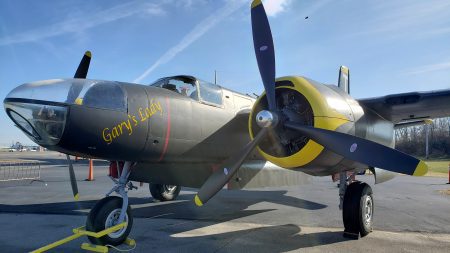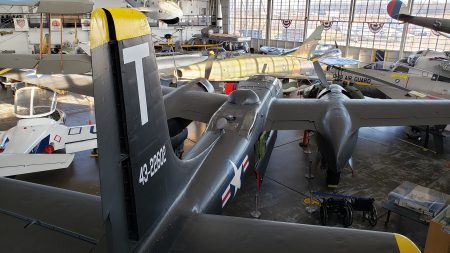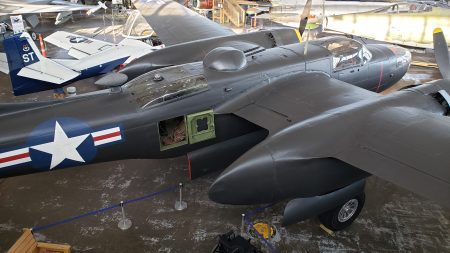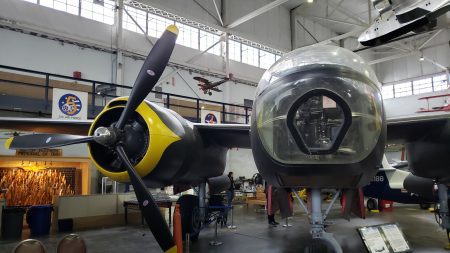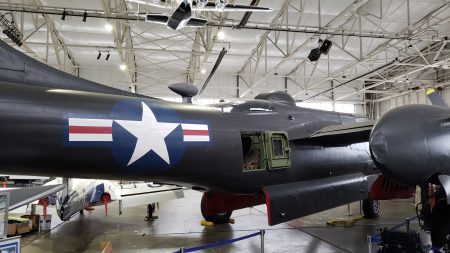Our Aircraft’s History
Douglas A-26C-25-DT “Invader” (S/N 43-22602; MSN 18726) ~ The Invaders were the last propeller-driven twin-engine bomber produced for the US Air Force and also unusual for it being a single-pilot bomber. The A-26 was designated the B-26 (to much confusion with the Martin B-26 Marauder) from 1948-1965.
Our light bomber was manufactured by Douglas Aircraft in Tulsa, Oklahoma and delivered to the US Army Air Force on February 23, 1944. She was sent to Hunter Army Air Field, Georgia and departed the United States for assignment with the 9th Army Air Force in France at the tail end of Word War II. Below you will see her actions in WWII and the Korean War:
- August 1945 – 487th Army Air Force (AAF) Base Unit, Air Transport Command, Hunter Army AF, Georgia
- January 1946 – 4255th AAF Base Unit (Air Material Command) Grenada Army Air Field, Mississippi
- April 1946 – 4160th AAF Base Unit (AMC), Hobbs Air Force Base, Texas; redesignated B-26C
- June 1947 – Warner-Robbins Air Material Center (AMC), Robbins AFB, Georgia
- March 1948 – 47th Maintenance & Supply Group (Tactical) Air Command, Biggs AFB, Texas
- March 1949 – 47th Air Base Group (TAC), Barksdale AFB, Louisiana
- August 1949 – Ogden Air Material Area, Hill AFB, Utah
- June 1950 – 3800th Air University Wing (Air University Command), Maxwell AFB, Alabama; transferred to the Ogden Air Material Command, Utah
- September 1950 – 452nd Bombardment (Light) Group (Continental Air Command), Victorville AFB, California
- October 1950 – 2347th Air Force Reserve Training Center (US Air Force Reserves), Long Beach AFB, California
- March 1951 – Sacramento, Air Material Area, McClellan AFB, California
- May 1953 – 3rd Bombardment Wing (Light), Far Eastern Air Forces, Iwakuni AB, Japan
- July 1953 – 3rd Bombardment Wing (L), FEAF, Kunsan AB, Korea and Miho AB, Japan
- October 1954 – 3rd Bombardment Wing (L), FEAF, Johnson AB, Japan
- August 1956 – Sacramento, Air Material Area, McClellan AFB, California
- September 1956 – 2469th Air Reserve Flying Center (AFRES), Scott AFB, Arizona
- June 1957 – Placed in storage at the Aerospace Maintenance and Regeneration Center (AMARC), Davis-Monthan AFB,Arizona
- November 1957 – Dropped from inventory as surplus. Sold to On-Mark Engineering Company, Van Nuys Airport, California; converted to On-Mark Marketeer
- January 1964 – Corporate ownership, Taywin Investment Company, Lakewood, Colorado
- March 1966 – Corporate ownership, Kimberly Leasing Corporation, St. Paul, Minnesota
- June 1970 – Private owner, New London, New Hampshire
- May 1972 – Private owner, placed in open storage in Springfield, Vermont
- January 1974 – acquired by MARC, Chino, California; damaged in transit to Orlando, Florida
- June 1975 – Display at Wings and Wheels Museum, Orlando, Florida
- August 1984 – On display at 94th Aero Squadron Restaurant, in West Palm Beach, Florida
- January 2000 – Placed on loan to the Historical Aircraft Squadron, Fairfield County Airport, Lancaster, Ohio
Arriving on February 11th, 2012, she finally resides at her current spot, the MAPS Air Museum. Fully restored to museum status, this Invader is maintained by Crew Chief Ken Ramsay.
Specifications/Performance
- Role: Ground attack/light bomber

- Manufacturer: Douglas Aircraft Company
- First flight: July 10, 1942
- Introduction: June 30, 1943
- Retired: June 1, 1972 (US); 1980 (Colombian Air Force)
- Produced 1942-1945
- Built: 2,452
- Unit cost: $242,595 (1942)
- Crew: 3
- Length: 50 ft
- Wingspan 70 ft
- Height: 18 ft 6 in
- Empty weight: 22,370 lb
- Max takeoff weight: 35,000 lb
- Engines: 2 x Pratt & Whitney R-2800-71 Double Wasp 18-cylinder cooled two-row radial pistons, 2,000 hp each
- Max speed: 359 mph at 16,700 feet
- Cruise speed 284 mph
- Range: 1,600 mi at 5,000 ft
- Combat range: 610 mi
- Ferry range: 3,000 mi
- Service ceiling: 28,500 ft
Armament, notable
- Guns: 6 or 8 12.7 mm M2 Browning machine guns in the nose
- Up to 8 .50 in M2 machine guns paired in four optional pods
- 2 x .50 in M@ machines guns, each, in remote-controlled dorsal and ventral turrets
- Rockets: Up to 10 5-inch HVAR rockets
- Bombs: Up to 6,000 lb capacity
Museum display notes: displayed as a night bomber during the Korean War as part of the Fifth Air Force, 3rd Bombardment Wing
Designed to replace: Douglas A-20 “Havoc”
Intended replacement: Martin B-57 “Canberra”

